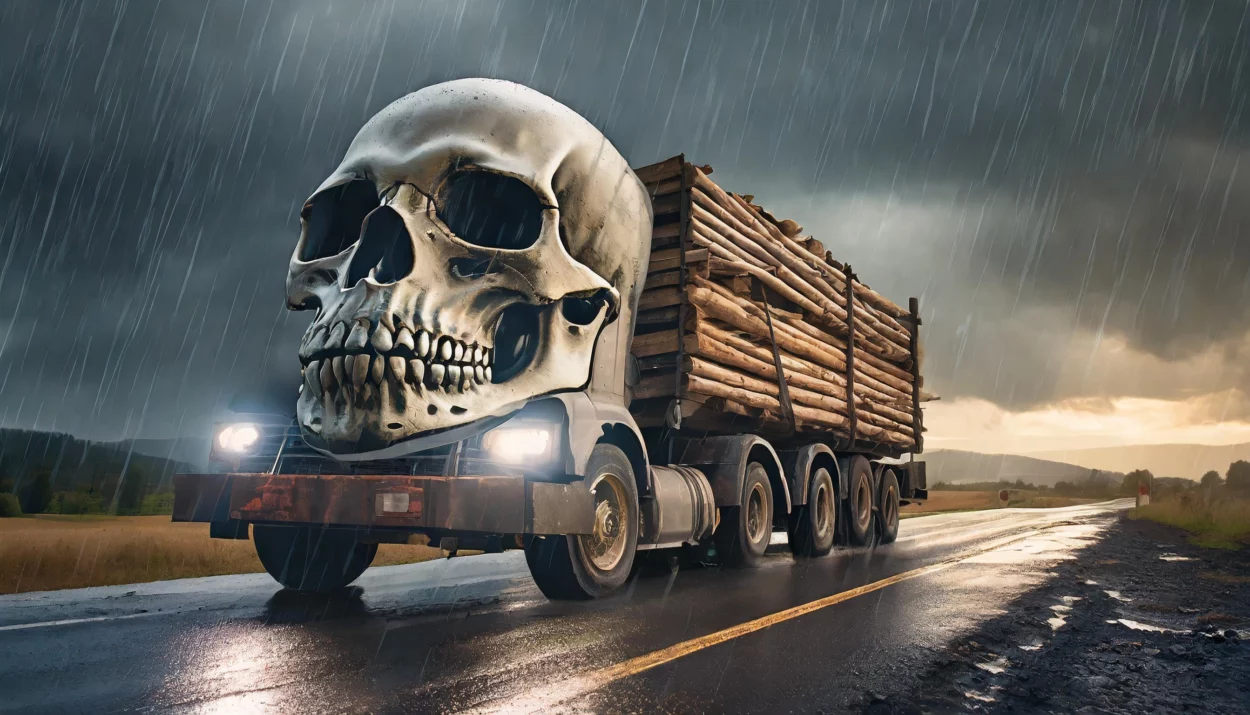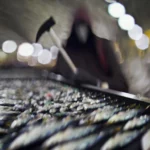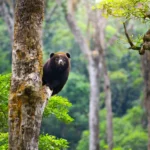This topic was completely unplanned. Over the past few days, I've been reorganising my blog quite a bit. Over the years, some content has been created on two major topics: Health and nature conservation. Whilst I deliberately chose to write about my health, when it comes to nature conservation I can't help myself. I simply have too much time on my hands, and the subject matter captivates me. And so strange things like yesterday happen. From our WhatsApp children's chat:

The context in which I know the spurge is the greening of garage roofs. As there are countless species with different flowering periods and also hardy species, the spurge is very suitable for greening. Although plants aren't really my thing, I found this exciting again. Because it shows that nature always finds a way.
The idea to write about plants and forests today came to me as I was skimming through my emails. Once again there was a petition. Today it was from Greenpeace, of which I am a member, to protect domestic and international forests. Specific demands include banning trade in products from forest destruction and adopting clear measures to implement the Paris Climate Agreement. Sounds understandable at first. But Greenpeace co-founder Paul Watson would probably say typical Greenpeace. Okay, that was a bit of a stretch...
Those of us who are older - so my age is pretty much mid-40s+ - may still remember the pictures from the 80s. Greenpeace was new on the international playground of the world's oceans. The big media issue at the time was seal hunting. They wanted white fur for the textile industry.
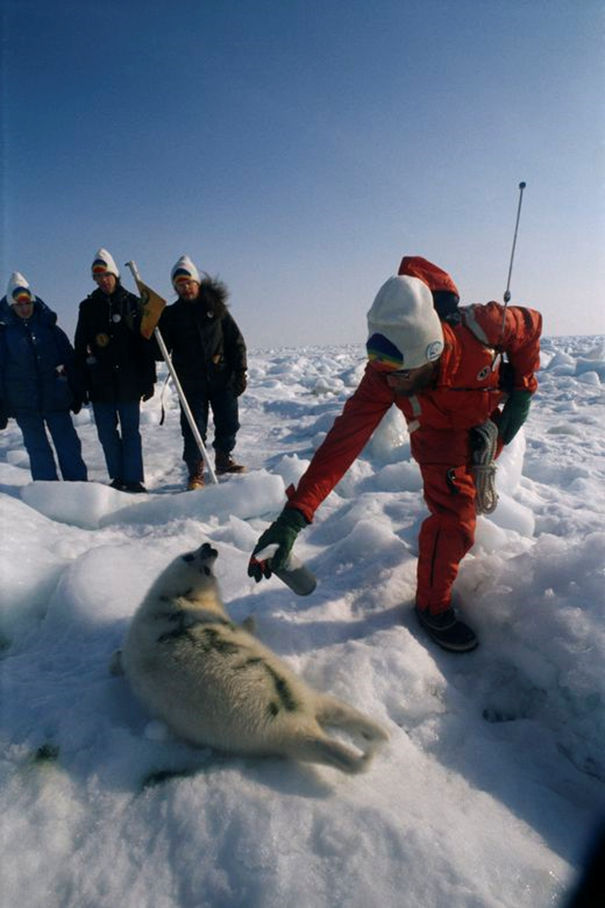
I borrowed the picture from the mirror. I have the scene from the film exactly in my head. If you know what you're looking for, the rest is child's play. The Spiegel website, which had exactly the photo I need to tell you about the forest. I hope that the image rights are owned by Greenpeace and that they don't sue their own members. You can't even be that sure among environmental activists. The second action I remember is the chaining to the poachers' ships and "blocking the way" by activists sitting on the ice floes directly in front of the hunters' icebreakers. I call them poachers. Just because seal hunting was allowed doesn't change the fact that poaching and plundering took place. Anyway, in the next photo you can see the co-founder Paul Watson sitting in front of a boat. And was later thrown out of his own organisation because he was said to have become "too radical" for Greenpeace.

This photo is from Paul's new organisation, the Captain Paul Watson Foundation. But it was founded not so long ago. In between, there was Sea Shepherd, a movement that had the unconditional protection of the oceans as its primary goal. Unlike Greenpeace, Sea Shepherd did not want to cave in to politics and lobbies. Three guesses who founded Sea Shepherd. And you can guess three more times who was thrown out of Sea Shepherd, now lives in exile in Australia and is allowed to defend himself and others from the movement in European courts. Because he had become "too radical" for Sea Shepherd.
And this brings us full circle to the Greenpeace petition. It looks quite nice on paper and Greenpeace can write in its annual report that it has done something. And not much more is to be expected.
Let's assume for a moment that anyone in national, European or international politics would be interested in petitions. Which is measurably not the case. As far as I know, there is not a single environment-related petition that has ever led to a sustainable realisation of the demands. That is really sad. The few successful citizens' initiatives that have actually made it into parliament have either been implemented in completely ineffective wishy-washy laws ("Save the bees") or the environmentalists have simply been allowed to celebrate their staged success. Shortly afterwards, when the dust had settled, all previous resolutions were quietly overturned and the laws reversed ("Glyphosate ban in the EU").
So. But let's assume for a moment that our politicians do take such petitions seriously. Then nothing will happen anyway. Let's start from the back. A roadmap with concrete measures to achieve the goals of the Paris Climate Agreement. For anyone who no longer has this on their radar, the three main goals of the agreement are set out in Article 2:
- Limiting the rise in the global average temperature
- Reducing emissions and adapting to climate change
- Steering financial resources in line with climate protection targets
The targets are specified further down. You can also read about the famous 1.5 degrees. I don't know what we imagine a petition is supposed to achieve. We have missed the target. In October last year, NASA satellites measured that we are on average more than 1.5 degrees warmer than in the pre-industrial age. This train has long since left the station. As things stand today, it's all about damage limitation.
As far as financial resources and adaptation to climate change are concerned, I can't think of anything right now except to throw the question into the room of how it was with the phase-out of fossil fuels such as coal and natural gas. It's all bullshit. On the contrary, we are so stupid and even subsidise when someone burns virgin forest in the oven. So we can cancel Paris. That's it.
So let's focus on the forests. The central demand is to stop the trade in goods whose production requires the clearing of forests. That's all well and good, but that won't happen either. It's a bit like improving the conditions under which animals are kept. As long as consumers are not prepared to change their lifestyles and demand environmentally harmful products, there will always be someone offering them. Which brings us to the next problem. The labelling of goods.
For consumers to be able to make an informed decision about what they buy, they need to be clearly told what is in the pack and what is not. I ordered toilet paper yesterday. The paper is already in the name. It's predestined to be made from cleared forests. But now I need to find an alternative.
I have the advantage that I don't need toilet paper. I wear nappies and you won't get very far without wet wipes. But my carers, who are with me around the clock, visitors, friends and family all have a need sooner or later. So I go on a search. And I realise that without writing to all the manufacturers, I don't see any way of making an informed decision. Quite simply, nobody tells you what raw materials they use in which toilet paper. I then ordered one which, according to the manufacturer, (also) uses straw. You don't know exactly how much straw. Not much. But I thought to myself, of all the bad products, I'll choose one that contains straw as well as deforestation, because that means there's less forest in it. Hope dies last.
And then there is the question of what exactly is being cut down. What we call a forest today is not a forest. They are man-made monocultures that contribute nothing to biodiversity, offer hardly any real habitat and make no significant contribution to climate protection.
For a tree to be able to store any significant amount of CO2, it has to be at least thirty years old. And we learned as children at school that the colour green in nature has something to do with the fact that the climate-damaging greenhouse gas CO2 goes in and miraculously the finest oxygen (O2) comes out all by itself. That's totally cool. Doesn't cost us a cent, works forever and ever and never runs out. But we need green. A photo of the Peruvian Secret Forest, which you protect with every item you buy from my shop, illustrates the problem. This is what it looks like when a tree in a real forest is measured.
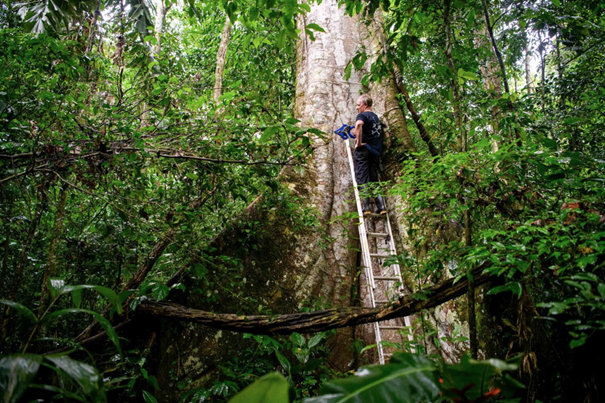
Image source: https://wilderness-international.org/region/secret-forest
Yes, that's forest, that's what it looks like. The picture is from Wilderness International. They certainly won't grumble if I use it because... well, because. Not to be compared with the tragedy that we call a forest in this country. To be clear from the outset, this is not a shot of the trees at the side of the road from a motorway service area in Saxony. No, this shot is from an article by ARD alpha and shows a Bavarian Alpine forest.

Image source: https://www.ardalpha.de/wissen/natur/pflanzen…
What were once resilient mixed forests are now giving way to monocultures of spruce and pine. You can break off the trees at the root as they are and pack them in matchboxes. Take another look at the two pictures. I apologise for being so critical. As so often, I quote my favourite Benecke: this is measured, not my opinion.
Today's "forests" are nothing more than plantations of monocultures of the same trees planted far too close together. After all, the trees were planted for profitable timber extraction and not for the sake of nature. As soon as the first seedlings get light on the spot, a race for time begins. Because they are planted far too densely, they rob each other of the sunlight. In order to get a few rays of light, the trees shoot up like matchsticks.
The next big problem is that the treetops spread out in order to get as much light from the sun as possible. A dense carpet forms at lofty heights that does not let any light through. Have you ever noticed that our forest floors all look the same? At the edge of footpaths, where some light shines through the aisle, you might find a few blueberries or, if you're very lucky, a mushroom. With a lot of luck, the spore body of this mushroom is edible. With even more luck, it might even be edible. I wouldn't bet on it. But apart from the plants at the edge of the forest, there is practically only moss. No shrubs, flowers, bushes or small trees stand a chance. In these conditions, with practically no daylight, moss is the only thing that can survive.
Better than nothing, you might think. Unfortunately, the selection of species that live in the moss of a dark forest floor is rather limited. Nothing compared to the fertile soil of a healthy forest.
The crux of the story: nowhere else on earth does it look better. In Germany, there is still some forest in nature parks. The situation is similarly bleak at European level. In the Mediterranean region, everything burnt down last summer due to the unspeakable heat. Literally. There haven't been as many forest fires as there are now since... I'd have to do some research, probably not since an asteroid could have contributed to the extinction of the dinosaurs.
The few forests that still exist in Romania, Slovakia and Ukraine, for example, are being destroyed on a grand scale right now. Eastern Europe has rediscovered wood as the new gold and is mercilessly clearing millennia-old primeval beech forests in the Carpathians. Do you know beech? No, you don't. The beech trees that are currently being cut down in Romania are up to 60 metres high. Imagine standing on the ten-metre tower in a swimming pool for the first time. To be honest, I've always had respect for the five-metre tower because I had to hold my nose when diving and, oh yes, I always thought it was rather average. But never mind. So now we're standing on the ten and looking down into the depths of the pool. And now you imagine that there's another one on the ten-metre tower. You climb up. You've managed twenty metres. And another one. You now look down thirty metres. Thirty metres, that was the highest I've climbed indoors and old Swiss, everyone advises you not to look down. What do you do when you've scrambled 30 metres up a 7-metre wall and your outstretched hand reaches the 30-metre mark? Thirty metres is pretty high. Now we double it again and reach a height of 60 metres. We cut down this type of primeval tree right on our doorstep.
It's easy to point the finger at others. Of course the Amazon is important and the slash-and-burn there sucks. But as long as we insist on eating meat, we will have to feed the animals with something. The meat consumer doesn't want to pay for quality feed. Consumers only want pretty seals of approval and animal welfare labels as long as they don't cost anything. They only serve to soothe their own conscience. When it comes to money, the consumer doesn't give a damn how the animals fared when they were alive and dead. So we continue to buy soya from South America as feed for our "farm" animals, even though we have known for decades what is happening to the few remaining rainforests on this planet.
Don't you also find it arrogant to point to the poorest countries in the world, even though they only do what we demand? While we can't even manage to make the same problem socially acceptable in our own neighbours? I'm not even talking about stopping all this shit. We can't even get the issue into the pubs. Or are they still empty after corona, because the common man can have one fag after another for ten euros a day, but now he has to pay 19% VAT again instead of the pandemic-related 7%, no, there's not enough money for that now. Next thing you know, the farmers will take to the streets because the subsidies on agricultural diesel will now be phased out as planned from the outset.
Back to the topic. I bet you didn't know that Romania is systematically cutting down primeval forests to make pellets, which are then burnt in pellet stoves that are supposedly climate-friendly. When I first heard about this, I was shocked.
It's hair-raising. Throughout the EU, wood is considered a green energy source and is therefore subsidised by the state so that it works for the consumer. Well, that's not what I learnt in my business studies about how markets work. But that was a while ago. I was still studying for a degree. It hasn't existed as a degree programme for a few years now.
What finally escapes my understanding is how wood pellets are supposed to be climate-neutral. This is so typical of European environmental policy, a policy of looking the other way.
In theory, pellets are made from sawdust as a waste product. But everyone knows that this will never happen. The deforestation of rainforests makes the sale of pellets much more attractive. The timber mafia is not interested in anything except profit. And the gold of our time sells well. So well, in fact, that the British have started converting their coal-fired power stations to run on pellets. When the day comes that I read in the newspaper "England buys EU-subsidised wood pellets that don't even come from the EU"...
But even small-scale domestic combustion doesn't add up. If anyone can explain to me what mysterious factor in the climate balance I am overlooking, I would really like to understand it. I'm clearing a primeval forest. The trees are all over thirty years old and bind tonnes of CO2 in their biomass. To give you another illustrative example, a primeval forest stores around 428,400 kg of CO2 in the area of a football pitch. When wood is burnt, it releases CO2 back into the atmosphere. This is harmful to the climate and subsidising it is in stark contradiction to the Paris Climate Agreement. According to the third principle, Article 2 "Steering of financial resources in line with climate protection goals", virgin forest wood pellets may not be subsidised by the state. Has anyone ever thought of filing a corresponding lawsuit against the EU? What's more, the trees removed will no longer store CO2 in the future. This means that the production of pellets with all the heavy agricultural machinery far out in the forests is definitely climate-negative. Combustion is climate-negative according to all the rules of chemistry. And in the long term, the process is also climate-negative due to the removal of the trees. I'm not joking. What step have I forgotten that makes heating or using pellets to generate electricity climate-neutral according to the EU? I know a thing or two about balancing. I did it at university. Okay, a long time ago. But primary school pupils would realise that minus + minus + minus cannot be zero.
On the entire planet, only 2.8% of the land surface still offers intact habitats. As much as I would like to see a petition succeed, it's not going to happen. It's time to act. It's already too late anyway. It's going to be shit anyway. We have it in our hands how much it will suck.
And when I say action, I mean exactly you. Yes, yes, as a reader of my blog, it's not easy. I'm constantly being asked to think about something. But tomorrow's instalment will be all the more shallow. It's Sunday, if I haven't miscalculated. Today is Thursday. You've practically just read in the past, even though you've moved forwards in space. Fascinating.
Click here for the forest petition: https://act.gp/3ExJLm3 Of course I have signed them.
Click here for the old Romanian Virgin Forest petition: https://greenpeace.at/petitionen/karpaten-waelde… What a question, of course.
And because this topic has been on my mind for, well, decades, there are also matching shirts in my merch shop. The proceeds are used to finance the purchase and permanent protection of rainforest in Peru. How fitting.

https://shop.paddys.de/product/think-care-act-t-shirt-rainforest-womens/
think care act T-shirt "Rainforest" | Women's
€30
More than half of Earth's rain forests have already been lost due to the human demand for wood and arable land. Rain forests that once grew over 14 per cent of the land on Earth now cover only about 6 per cent. And if current deforestation rates continue, these critical habitats could disappear from the planet completely within the next hundred years. (National Geographic)
Artist: Layan | insta @wakheshandesign

https://shop.paddys.de/product/greetings-card-european-deforestation-square-portrait-125cm-x-125cm/
Greetings Card Deforestation
€5
Unprotected EU forests are being logged for pulp, paper, and bioenergy, though even protected forests sometimes suffer the same fate. The European Environment Agency's 2019 State of the Environment report shows that 80 per cent of EU forests with protected status are in an unfavourable or bad conservation state. (fern)
Artist: Paddy | insta @paddylicious
⚖ 340gsm high quality 🤍 white woodfree uncoated 🍁 natural offset paper 🍓 produced using pulp in white 🍃 organic 🌱 vegan 🌳 saves 1 sqm rainforest 💨 produced with renewable energy 💧 sewage drinking quality 🌿 plant-based packaging 💚 made for you with love ❌ cruelty-free ❌ not tested on animals ♻ renewable 💲 non-profit

https://shop.paddys.de/product/greetings-card-european-forests-square-portrait-125cm-x-125cm/
Greetings Card European Forests
€5
In 2022, 37 per cent of Mediterranean and central European forests were affected by tree browning. Droughts and heatwaves are causing Europe's forests to turn brown in the summer months. (euronews)
Artist: Paddy | insta @paddylicious
⚖ 340gsm high quality 🤍 white woodfree uncoated 🍁 natural offset paper 🍓 produced using pulp in white 🍃 organic 🌱 vegan 🌳 saves 1 sqm rainforest 💨 produced with renewable energy 💧 sewage drinking quality 🌿 plant-based packaging 💚 made for you with love ❌ cruelty-free ❌ not tested on animals ♻ renewable 💲 non-profit

https://shop.paddys.de/product/think-care-act-t-shirt-rainforest-kids/
think care act T-shirt Rainforest | Kids'
€17
More than half of Earth's rain forests have already been lost due to the human demand for wood and arable land. Rain forests that once grew over 14 per cent of the land on Earth now cover only about 6 per cent. And if current deforestation rates continue, these critical habitats could disappear from the planet completely within the next hundred years. (National Geographic)
Artist: Layan | insta @wakheshandesign

https://shop.paddys.de/product/think-care-act-t-shirt-forest-bee-womens-relaxed-fit/
think care act T-shirt Forest Bee | Women's Relaxed Fit
€30
Bees are at risk of extinction largely due to human activities: large-scale changes in land use, industrialised agricultural practices, like monocultures, and the detrimental use of pesticides have all contributed to destroying their habitats and reducing their available food sources. (FairPlanet)
Artist: Layan | insta @wakheshandesign

https://shop.paddys.de/product/greetings-card-forest-bee-square-portrait-125cm-x-125cm/
Greetings Card Forest Bee
€5
Bees are at risk of extinction largely due to human activities: large-scale changes in land use, industrialised agricultural practices, like monocultures, and the detrimental use of pesticides have all contributed to destroying their habitats and reducing their available food sources. (FairPlanet)
Artist: Paddy | insta @paddylicious
⚖ 340gsm high quality 🤍 white woodfree uncoated 🍁 natural offset paper 🍓 produced using pulp in white 🍃 organic 🌱 vegan 🌳 saves 1 sqm rainforest 💨 produced with renewable energy 💧 sewage drinking quality 🌿 plant-based packaging 💚 made for you with love ❌ cruelty-free ❌ not tested on animals ♻ renewable 💲 non-profit

https://shop.paddys.de/product/think-care-act-sweater-rainforest-mens/
think care act Sweater "Rainforest" | Men's
€53
More than half of Earth's rain forests have already been lost due to the human demand for wood and arable land. Rain forests that once grew over 14 per cent of the land on Earth now cover only about 6 per cent. And if current deforestation rates continue, these critical habitats could disappear from the planet completely within the next hundred years. (National Geographic)
Artist: Layan | insta @wakheshandesign

https://shop.paddys.de/product/greetings-card-rainforest-square-portrait-125cm-x-125cm/
Greetings Card Rainforest
€5
More than half of Earth's rain forests have already been lost due to the human demand for wood and arable land. Rain forests that once grew over 14 per cent of the land on Earth now cover only about 6 per cent. And if current deforestation rates continue, these critical habitats could disappear from the planet completely within the next hundred years. (National Geographic)
Artist: Paddy | insta @paddylicious
⚖ 340gsm high quality 🤍 white woodfree uncoated 🍁 natural offset paper 🍓 produced using pulp in white 🍃 organic 🌱 vegan 🌳 saves 1 sqm rainforest 💨 produced with renewable energy 💧 sewage drinking quality 🌿 plant-based packaging 💚 made for you with love ❌ cruelty-free ❌ not tested on animals ♻ renewable 💲 non-profit

